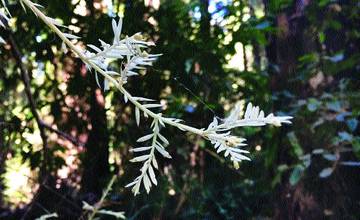The redwood appears like a phantom as if from thin air. What looked like a trick of the light a moment ago materialises into a trunk branches needles mdash; a tree roughly the height of a man with delicate leaves the colour of bone. It is an albino redwood the ldquo;ghostrdquo;: of California’s coastal forests. ldquo;I like that metaphor a lotrdquo; says biologist Zane Moore as he grasps a branch of the unusual conifer and holds it up to the light.
Brilliant October sunshine filters through the high forest canopy where the silver-green needles of healthy trees soak up rays and turn them into fuel. But the albino tree lacks chlorophyll and is incapable of the one thing all trees must do to live. ldquo;It shouldnrsquo;t be here. It should be dead but it’s notrdquo; says Moore. ldquo;Just like a ghost.rdquo;
The mystery of the albino redwood has stumped researchers for more than a century. The trees are so improbable that those who havenrsquo;t seen them up close sometimes question whether they can exist at all. But Moore is convinced this ghost story has a scientific solution mdash; one that should change how we view not just the albino trees but also the entire forest. He’s a doctoral student at the University of California in Davis with a professorial manner and an easy smile. He’s been visiting Henry Cowell Redwoods State Park an old-growth redwood grove near Santa Cruz since he was a child and spotted his first albino redwood here at 16.
For the treesrsquo; own protection staff at the park typically donrsquo;t tell visitors how to find them. ldquo;Trees can be loved to deathrdquo; says Dave Kuty. ldquo;Theyrsquo;re not like animals. They canrsquo;t run away.rdquo; He’s the unofficial caretaker of Henry Cowell’s 11 albinos and he alone knows where each one hides. Some look like haphazardly spray-painted bushes while others resemble the artificial white trees sold around Christmas. Still others are little more than single luminous branches high up in the canopy barely discernible in the shifting morning sun.
As a teenager in 2010 Moore heard Kuty give an interview to a local radio station about the redwoods and he set out to track one down for himself. That quest won Moore membership into the loose group of botanists park rangers and enthusiasts devoted to understanding the enigmatic trees. Now he is among the foremost experts on the albino redwoods of the Santa Cruz mountains. And he’s only 22.
It helps that hardly anyone else has studied them. Albinos are exceedingly rare mdash; there are only 406 in existence by Moore’s latest count. And redwoods as a species are notoriously complex. Their genomes have 32 billion base pairs to humansrsquo; 3.2 billion and they carry six copies of each chromosome instead of two. No one has successfully sequenced the redwood genome making it impossible to pinpoint the mutation that causes their albinism.
Redwoods can also clone themselves further complicating scientistsrsquo; understanding of them. Vast rings of related plants communicate via their roots and during the hard months of winter and early spring theyrsquo;ll distribute nutrients evenly among themselves. Scientists have spilled dye onto trees at one end of a grove and traced it through the root network all the way to the other side. ldquo;Most people when they come to the redwood they look up at the canopyrdquo; Kuty says. ldquo;But down is where the action is.rdquo;
This collaboration lasts only until summer comes. Then every tree sprout and branch must fend for itself. Those that canrsquo;t photosynthesise enough sugar are cut off from the shared root system and discarded during what’s known as the autumn ldquo;needle droprdquo;. That shedding process is taking place at Henry Cowell. Bits of branches drift hundreds of feet down from the canopy buffeted by a soft breeze. The air carries the scent of wood smoke and the spicy aroma of crushed leaves. The redwoodsrsquo; great age and immense height mdash; coast redwoods Sequoia sempervirens are the tallest organisms on the planet and live as long as 2500 years mdash; give the forest a cathedral-like quality.
But Moore looks down as he explains how albino redwoods take advantage of their shared root system by siphoning off sugars produced by their healthy neighbours. ldquo;A lot of people thought they were parasitesrdquo; he says. ldquo;They even called them lsquo;vampire treesrsquo;.rdquo; But that interpretation never made sense to him. If redwoods were so ruthless about sloughing off unproductive branches it seemed unlikely that they would tolerate a parasite year after year. ldquo;Redwood trees are smarter than thatrdquo; he says. He looks around at the towering green trees that surroundnbsp; mdash; and presumably sustain mdash; the small albino. ldquo;Why why why?rdquo;
Moore and a colleague arborist Tom Stapleton set out to document the locations of every known albino redwood. Their map revealed that white trees tended to grow where the conditions become less favourable mdash; a hint that environmental pressure might allow the mutants to thrive. Next Moore sought help from his fellow redwood fans up and down the California coast soliciting clippings from both albino trees and their healthy hosts. He found that the albino needles were saturated with what should have been a deadly cocktail of cadmium copper and nickel. On average white needles contained twice as many parts per million of these noxious heavy metals as their green fellows; some had enough metals to kill them 10 times over. Moore thinks faulty stomata mdash; the pores through which plants exhale water mdash; are responsible: plants that lose liquid faster must also drink more meaning that the albinos have twice as much metal-laden water running through their systems.
Moore studies the most-poisoned albino tree he has found; it has more than 10 times the healthy levels of nickel in its leaves. His theory mdash; which he presented at a redwood conference last month and hopes to publish next year mdash; is that albino redwoods are in a symbiotic relationship with their healthy brethren. They may act as a reservoir for poison in exchange for the sugar they need to survive. He acknowledges he needs to study the phenomenon further. His next experiment will involve dousing lab-grown green and white redwoods with nickel to see whether the plants with an albino partner stay healthier. He also wants to test whether the heavy metals in albino trees stay bound up in the plants or eventually leak back into the soil. If his theory does turn out to be valid he can envision a day when albino redwoods are planted in polluted areas to help make the soil safer for other trees.
nbsp;
-The Washington Post











